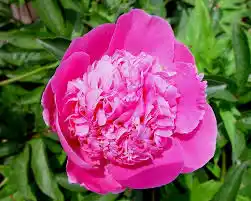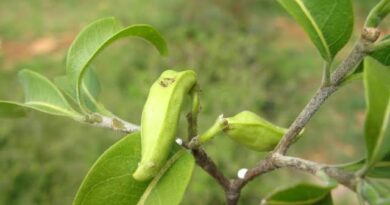Health Benefits and Uses of Uda Tree (Negro Pepper)
Uda tree (also known as negro pepper or grains of selim) are a spice commonly used in West African cuisine. The scientific name of uda is Xylopia aethiopica, and it belongs to the Annonaceae family.
The uda tree is native to West Africa, and its leaves, seeds, and fruits are used for medicinal and culinary purposes. Uda leaves have a slightly bitter and pungent taste, and they are often used to season soups, stews, and sauces.
Uda leaves are believed to have several health benefits, such as reducing inflammation, improving digestion, and treating respiratory infections. They are also used to relieve menstrual cramps and promote lactation in nursing mothers.
In traditional African medicine, uda leaves are used to treat various ailments, such as malaria, fever, and arthritis. However, it’s important to note that more research is needed to confirm these health benefits and potential side effects of consuming uda leaves.
Read Also: Anemone Flowers – All you need to know
Description of Uda Tree (Negro Pepper)

Uda leaves are a spice commonly used in West African cuisine. They are obtained from the uda tree, which is native to West Africa. The uda tree is a medium-sized deciduous tree that can grow up to 20 meters in height. It has a straight trunk, and its bark is smooth and grayish-brown.
Uda leaves are usually harvested from the uda tree during the dry season. The leaves are dark green in color, glossy, and oval-shaped. They have a slightly bitter and pungent taste, and a strong, aromatic flavor. The leaves are often used to season soups, stews, and sauces in West African cuisine.
Apart from its culinary uses, Uda leaves are also used for medicinal purposes in traditional African medicine. The leaves, seeds, and fruits of the uda tree are believed to have several health benefits, such as reducing inflammation, improving digestion, and treating respiratory infections.
They are also used to relieve menstrual cramps and promote lactation in nursing mothers.
15 Health Benefits of Uda (Negro Pepper)

Uda leaves, also known as negro pepper or grains of selim, are commonly used as a spice in West Africa. These leaves have many health benefits due to their unique composition of vitamins, minerals, and phytochemicals. Here are 15 health benefits of Uda leaves:
1. Digestive health: Uda leaves have digestive properties that help alleviate indigestion, flatulence, and bloating.
2. Anti-inflammatory properties: Uda leaves contain anti-inflammatory compounds that help reduce inflammation and swelling.
3. Pain relief: Uda leaves are used in traditional medicine to relieve pain, including menstrual cramps, joint pain, relief fever and headaches.
4. Immune system boost: Uda leaves contain antioxidants that help to boost the immune system and protect the body against diseases.
5. Respiratory health: Uda leaves have expectorant properties that help to clear mucus from the respiratory tract and alleviate coughs and colds.
6. Anti-cancer properties: Uda leaves contain phytochemicals that have been found to have anti-cancer properties.
7. Anti-microbial properties: The essential oils found in Uda leaves have anti-microbial properties that help to prevent the growth of bacteria, viruses, and fungi.
8. Cardiovascular health: Uda leaves contain compounds that help to lower cholesterol levels and improve blood flow, which can reduce the risk of heart disease.
9. Painful menstrual periods: Uda leaves can help to alleviate the pain and discomfort associated with menstrual periods.
10. Skin health: Uda leaves have anti-inflammatory properties that can help to reduce skin irritation and inflammation.
11. Oral health: Uda leaves have anti-bacterial properties that can help to prevent the growth of bacteria that cause gum disease and tooth decay.
12. Anti-aging: Uda leaves contain antioxidants that help to protect the body against the damaging effects of free radicals, which can accelerate the aging process.
13. Diabetes management: Uda leaves can help to regulate blood sugar levels and improve insulin sensitivity.
14. Liver health: Uda leaves can help to protect the liver against damage and improve liver function.
15. Weight loss: Uda leaves can help to boost metabolism and promote weight loss.
Read Also: Angelica Flowers – All you need to know
Uses of Uda (Negro Pepper)
Uda leaves, also known as negro pepper or grains of Selim, are commonly used as a spice in West African cuisine, especially in Nigeria. These leaves have a pungent, smoky aroma and a slightly bitter taste. Here are some of the uses of Uda leaves:
Flavoring agent: Uda leaves are commonly used as a flavoring agent in soups, stews, sauces, and marinades. They add a unique flavor and aroma to dishes and can enhance the taste of other ingredients.
Medicinal purposes: Uda leaves have been used in traditional medicine to treat various ailments such as stomach ache, toothache, and respiratory infections. They have antibacterial, antifungal, and anti-inflammatory properties.
Preservation: Uda leaves have preservative properties and can be used to extend the shelf life of food. They can be added to smoked fish, meat, or poultry to help prevent spoilage.
Natural insecticide: The essential oil extracted from Uda leaves is a natural insecticide and can be used to repel insects and pests. It can also be used as a fumigant to control insect infestations in stored grains.
Aromatherapy: Uda leaves can be used in aromatherapy to promote relaxation and relieve stress. The leaves are burned to release their aromatic compounds, which can have a calming effect on the mind and body.
Overall, Uda leaves are a versatile ingredient with numerous uses in cooking, medicine, and pest control.
How to Grow and Harvest Uda (Negro Pepper)

Uda leaves, also known as negro pepper, are a popular spice used in many West African dishes. They are relatively easy to grow and can be harvested multiple times a year. Below are some steps to follow when growing and harvesting uda leaves:
Choose a suitable planting location: Uda leaves grow best in well-drained soil with plenty of sunlight. They can be grown in containers or directly in the ground.
Prepare the soil: Before planting, loosen the soil and add compost or organic matter to improve soil fertility.
Plant the seeds or seedlings: Uda seeds should be planted about 1 inch deep and 6 inches apart. If using seedlings, plant them at the same depth as they were in their original container.
Water regularly: Uda plants require consistent moisture, so water them regularly. However, be careful not to overwater as this can lead to root rot.
Prune the plants: Uda plants grow quickly and can become bushy. Prune them regularly to promote healthy growth and to prevent the plants from becoming too large.
Harvest the leaves: Uda leaves can be harvested about 3-4 months after planting. Harvest the leaves by cutting them off at the stem. Leave some leaves on the plant to promote further growth.
Dry the leaves: Once harvested, the leaves should be washed and dried in a well-ventilated area out of direct sunlight.
Store the leaves: Once completely dry, store the uda leaves in an airtight container in a cool, dry place.
By following these steps, you can grow and harvest your own uda leaves and use them to add flavor to your favorite dishes.
Red Also: Why Term Insurance Could Be the Right Choice for You








